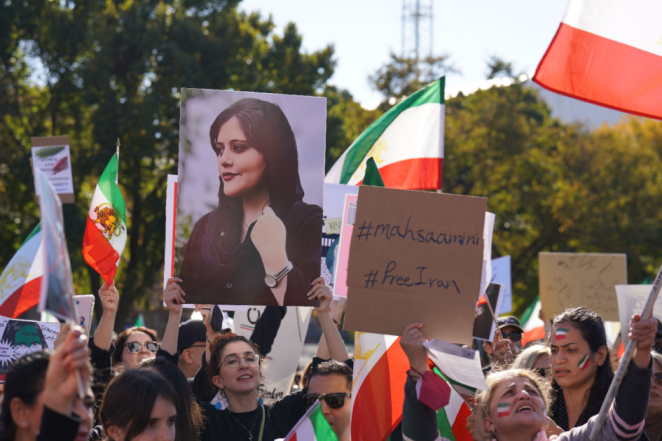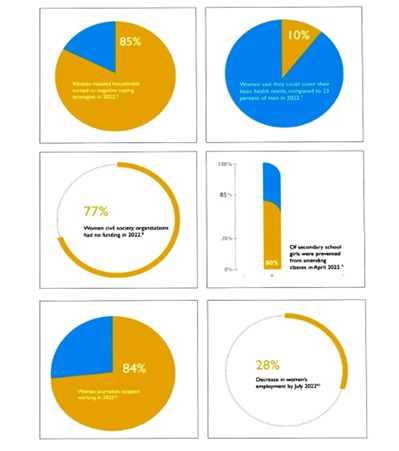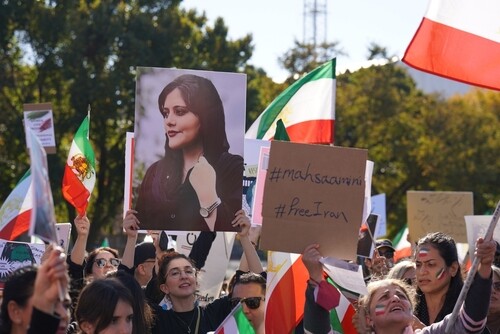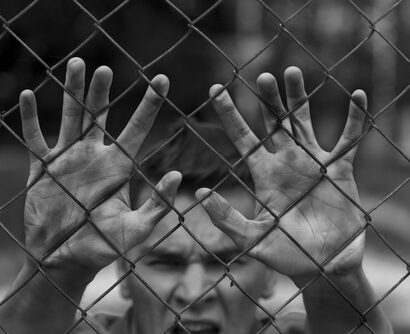Abstract: Despite international conventions, treaties, and organizations dedicated to gender equality, gender-based exploitation persists in many countries due to entrenched patriarchal structures and traditional norms. While significant progress has been made in recognizing gender discrimination and women’s rights throughout history, the rise of regionalism poses risks of moral relativism, where cultural and religious practices are invoked to justify the denial of women’s basic freedoms. The deterioration of fundamental liberties of women, the grave threats posed by war and conflict situations to women’s rights and the pernicious pattern of rollback of reproductive rights in various countries set a dangerous precedent and call for increased international attention and redressal on these matters.
Problem statement: How do entrenched patriarchal structures and adherence to conservative norms and conflict situations contribute to the persistence of gender-based exploitation and the denial of women’s basic freedoms in various countries?
So what?: There is an urgent need to identify the gendered aspects and related violations of human rights, specifically women’s rights, and mainstream them into the discourses in international politics. Governments, international organizations, and civil society should work together to ensure that women’s rights are not threatened during conflicts and that women are included in post-conflict reconstruction efforts and peace negotiations. The paper emphasizes the need for gender-sensitive policies and programs to address the gendered impacts of conflicts.

Source: shutterstock.com/Phil Pasquini
Women’s Rights as Basic Human Rights
The ambit of universal human rights has evolved progressively over the years to reach a level where women’s rights are considered a part of basic human rights, underlined by the understanding that women, who constitute half of humanity, are entitled to the full and equal enjoyment of their rights and to be free from all forms of discrimination.[1] The Convention on Elimination of all forms of Discrimination Against Women (CEDAW)[2] is considered a milestone document due to its significance as the women’s human rights treaty, ratified by over 189 state parties. Apart from legally binding the ratified countries to eliminate all forms of discrimination, it aims to achieve substantive equality and an enabling environment for women to practice their rights. The purview of disciplines such as Feminist International Relations and Feminist Security Studies also reiterated the importance of visibilising gender in international politics. It popularised the slogan “Personal is International and International is Personal”, thereby urging for the dismantling of the public-private dichotomy in global politics and emphasizing that women’s issues require global attention. Despite several international conventions and treaties promising gender equality, including the Universal Declaration of Human Rights, CEDAW and organizations and global institutional mechanisms such as the United Nations working towards the same, the reality of gender-based exploitation rooted in archaic traditions and age-old patriarchal structures denying women of the most fundamental rights, still lingers in a destructive pattern in many countries.
The Convention on Elimination of all forms of Discrimination Against Women is considered a milestone document. Apart from legally binding the ratified countries to eliminate all forms of discrimination, it aims to achieve substantive equality and an enabling environment for women to practice their rights.
Women, Life and Freedom
The tragic death of Mahsa Amini in suspicious circumstances under the custody of Iran’s notorious ‘morality police’ for allegedly violating the ‘hijab laws’ has sparked wide protests in the country. Thousands of people protested on the Iranian streets, chanting the slogan ‘Women, Life and Freedom’, expressing their dissent against the regime’s compulsory and often arbitrary hijab laws that mandate how women should dress and conduct themselves in public; these compulsory laws are a classic example of how authoritarian and patriarchal regimes can control women’s basic liberties. Iran’s protests which were triggered by opposition to hijab laws have now transformed into raising a broader and more radical demand for regime change causing political upheaval in Iran’s highest circles. The unrest among the public, provoked by Mahsa Amini’s death, has resulted from the dissatisfaction of the citizens caused due to economic depreciation and general misgovernance under the current Iranian regime. The government has accused the West of orchestrating these protests and has brutally cracked down upon the protestors by dishing out prison sentences and executions.
As we delve into the global landscape, it becomes evident that women’s rights face grave threats in various corners of the world. This reality finds a distressing confirmation in Afghanistan, where the recent Taliban takeover has led to an alarming erosion of women’s rights, leaving gender activists worldwide filled with apprehension. There has been a systemic attempt on the part of the Taliban regime to push women out of public life and impose egregious restrictions on them, starting from prohibiting women from accessing secondary education and, more recently, university education, preventing their access to public spaces such as parks and gyms and in extreme cases, arbitrarily detaining and torturing women protestors and denying them opportunities of employment.[3] The Ministry for Women’s Affairs was abolished, paving the way for the reinstation of MPVPV (Ministry for the Propagation of Virtue and the Prevention of Vice), signalling the systemic erasure of institutional mechanisms for protecting women’s rights and installation of morality watchdogs in its place symbolic of the age-old patriarchal traditions and stereotypes.
There has been a systemic attempt to push women out of public life and impose egregious restrictions on them, starting from prohibiting women from accessing secondary education, preventing their access to public spaces and in extreme cases, arbitrarily detaining and torturing women protestors and denying them opportunities of employment.
The statistical data presented below was published in UN Women Report on Women’s Rights in Afghanistan 2022,[4] one year after the Taliban takeover, bringing forth insights into the steady decline in living conditions for women within Afghanistan. It shows that about 77% of women’s civil society organizations had no access to funding in 2022, rendering them largely ineffective in working for the betterment of society. Almost 80% of girls in secondary school were prevented from attending school, and there has been a 28% decline in women’s employment (as per April 2022 data).

Source: UN Women Report on Women’s Rights in Afghanistan
The obliteration of women’s participation in public life is detrimental to the reconstruction and developmental prospects for the war-ravaged country of Afghanistan. It would exacerbate the grave economic challenges faced by the country. Taliban’s actions are expected to set back years of progress towards gender equality in Afghanistan and account for serious human rights violations of the country’s women.
Women’s Rights in Times of Conflict
A state of affairs characterized by conflict, violence, and war has historically put the most vulnerable sections of society in disproportionate neglect and exploitation. Women, therefore, often bear the brunt of global and domestic conflicts, as can be seen in the case of countries such as Sudan, Yemen, and Iraq.Along with the general breakdown of law and institutional mechanisms during times of conflict, which protects human rights, women face specific challenges during wars, including sexual violence through rape,[5] forced marriages, arbitrary killings, trafficking, and illegal detention; systemic rape as a tool for ethnic cleansing and destruction of communities has been a recognized war crime, which uses women’s bodies as ‘weapons of war’.[6] Such heinous acts, where women’s bodies become weapons of war, stand as recognized war crimes, perpetuating a cycle of devastation and eroding the very fabric of communities.
Amidst the backdrop of such conflicts, the repercussions extend far beyond the immediate battlegrounds. Conflicts exert pressure on the availability of resources for the population and redirect government revenue from social welfare measures to wartime expenses. This adversely affects vulnerable and historically disadvantaged sections, especially women and girls. It has been observed that dismantling the influence of civil and political institutions during conflicts adds to pre-existing and deep-seated gender inequalities in societies, which leads to regressive developments such as pushing women out of schools and universities, ignorance towards the protection of the civil and political liberties and an overall decreased attention paid to closing of the gender gap.
Conflicts exert pressure on the availability of resources for the population and redirect government revenue from social welfare measures to wartime expenses. This adversely affects vulnerable and historically disadvantaged sections, especially women and girls.
A report released by ORF,[7] highlighting the gendered costs of the Russia-Ukraine conflict, states that the conflict has impacted women of Ukraine adversely by rendering them more vulnerable to sexual violence and assault, hindered access to healthcare services, disproportionate migration and displacement of women, and the increased onus of caregiving and maintaining of families as the menfolk are away engaged in combat.
Reproductive Rights of Women
The overturning of the landmark judgment of Roe v. Wade by the US Supreme Court has brought the discourse of women’s reproductive rights back into the popular debate. The rollback of fundamental liberties like reproductive rights in a country like the United States, which touts itself as the global advocate of liberal individual rights, has served as a warning to gender activists about the grave threat looming large over women’s rights worldwide. According to the Center for Reproductive Rights, there are around 24 nations or territories with 91 million women of reproductive age having complete bans on abortion.
The reproductive rights of women in a society often determine the extent to which women can exercise their bodily autonomy unrestrainedly. However, ill-advised policies, often drafted without proper representation of women in policy-making and legislative circles, imposing blanket bans on abortions can have disastrous consequences. Women from marginalized and low-income backgrounds would bear the burden of such a decision as they cannot afford to travel to places where abortion is legal and will be forced to carry an unwanted pregnancy in fear of punishment. Restricted access to abortions will result in women resorting to unsafe abortions, posing a serious threat to their health and well-being.
Moral Relativism and Discrimination
Global society has made huge strides throughout history in recognizing gender discrimination and women’s rights. However, in today’s interconnected yet de-globalizing world order, increased regionalism holds within itself the danger of moral relativism, with religious and cultural practices embedded in the discriminatory social fabric of societies used to justify the arbitrary stripping of women of their most basic liberties. There is an increasing need to focus our attention on the gendered aspects of conflicts and encourage more women to be at the forefront of peace negotiations. The rollback of reproductive rights in any part of the world sets a dangerous precedent and threatens women’s bodily autonomy worldwide. The need for the discourse on international politics to assign increased importance to gender issues cannot be overstated. As the well-known women’s rights activist Alice Paul once said,” There will never be a new world order until women are a part of it”.
Nikhitha Nelson is a second-year Political Science honours student at Lady Shriram College for Women, New Delhi. Her research interests include feminist international relations, comparative politics and gender studies. The views contained in this article are the author’s alone.
[1] “Infographic: Human Rights of Women,” UN Women – Headquarters, https://www.unwomen.org/en/digital-library/multimedia/2019/12/infographic-human-rights.
[2] “Convention on the Elimination of All Forms of Discrimination against Women,” Convention on the Elimination of All Forms of Discrimination against Women (2011), https://www2.ohchr.org/english/bodies/cedaw/docs/CEDAW.C.AFG.1-2.pdf.
[3] “Afghanistan: Women Protesters Detail Taliban Abuse,” Human Rights Watch (2022), https://www.hrw.org/news/2022/10/20/afghanistan-women-protesters-detail-taliban-abuse.
[4] “Gender alert no. 2: Women’s rights in Afghanistan one year after the Taliban take-over,” n.d. UN Women, https://www.unwomen.org/en/digital-library/publications/2022/08/gender-alert-no-2-womens-rights-in-afghanistan-one-year-after-the-taliban-take-over.
[5] “Women’s human rights and gender-related concerns in situations of conflict and instability,” n.d., ohchr, https://www.ohchr.org/en/women/womens-human-rights-and-gender-related-concerns-situations-conflict-and-instability.
[6] Kelly Oliver, “Women as Weapons of War: Iraq, Sex, and the Media,” (Columbia University Press, 2007).
[7] Akanksha Khuller, “War’s Gendered Costs; The Story of Ukraine’s Women,” 2022, https://www.orfonline.org/research/wars-gendered-costs/#:~:text=The%20women%20of%20Ukraine%20are,to%20sexual%20violence%20and%20abuse.






